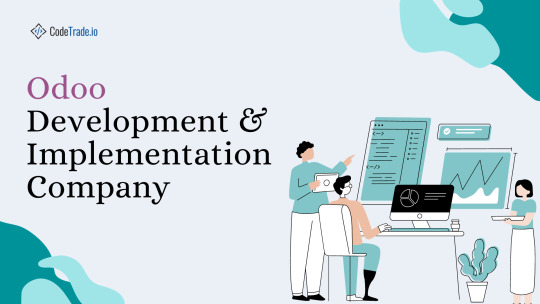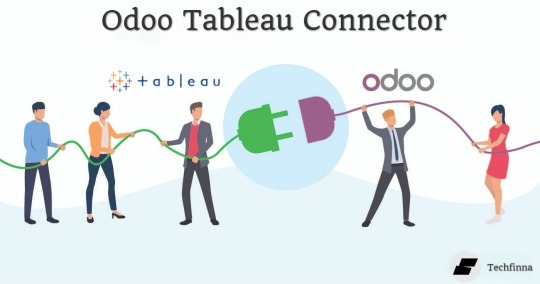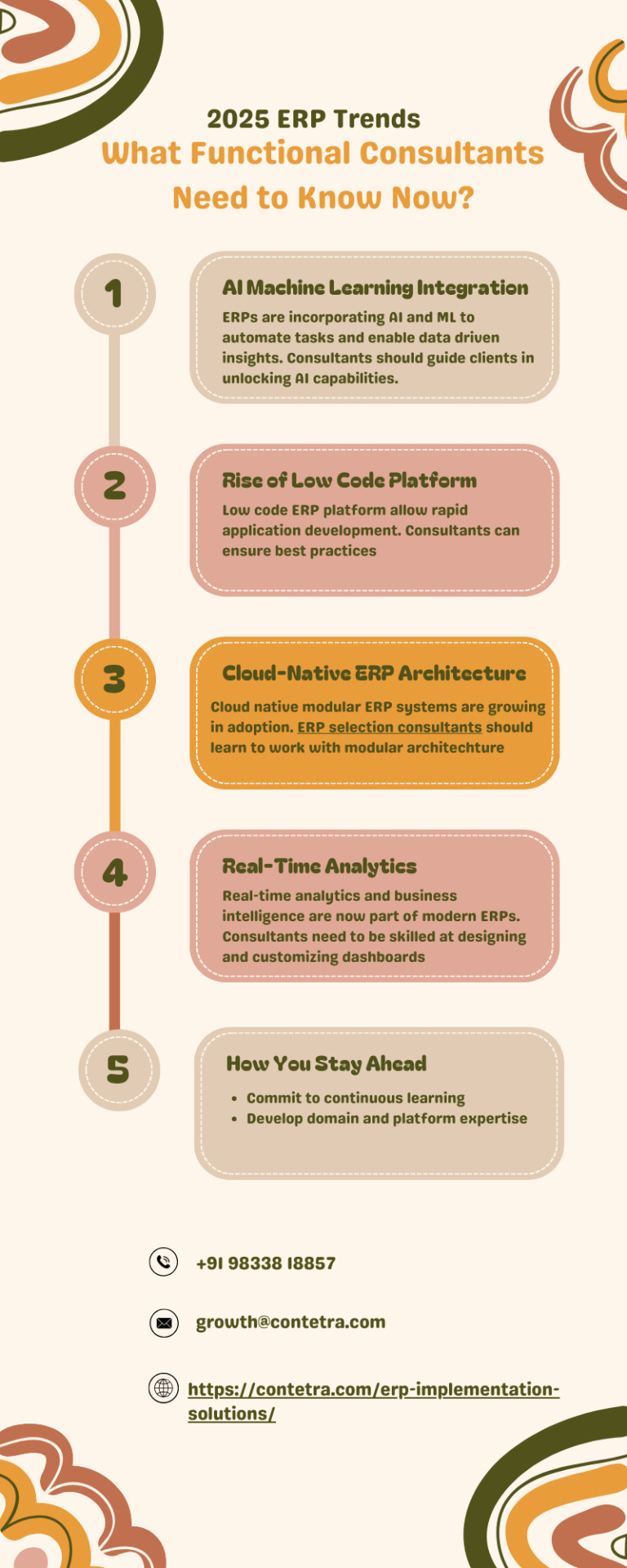#Odoo ERP provider
Explore tagged Tumblr posts
Text
Choosing Techbot ERP as Your Trusted Odoo ERP Provider
Techbot ERP stands out as a reliable Odoo ERP provider with a proven track record of successful implementations. With its comprehensive suite of Odoo ERP solutions, Techbot ERP caters to businesses of all sizes, offering seamless integration, customization, and ongoing support. As your Odoo ERP provider, Techbot ERP ensures a smooth transition to a robust ERP system that enhances efficiency, productivity, and business growth. Trust Techbot ERP as your preferred Odoo ERP provider for tailored solutions that meet your unique business needs.
0 notes
Text

Contetra enabled a smooth ERP migration for Multiplier by combining structured data audits, phased execution, and robust validation. Leveraging tailored ERP consulting solutions, the team reduced data migration time by 40%, ensured zero downtime, and delivered clean, consistent master data. This case study highlights the impact of expert-driven ERP implementation on business continuity and performance.
#erp implementation consultants#erp functional consulting#erp functional consultant#erp implementation#erp system implementation#odoo erp#erp system#erp software#odoo#erp#erp solutions provider#erp solution bd
0 notes
Text
Ecommerce Website Design Dubai

Webcastle understands the importance of Ecommerce website and we offer customization as per client requirements to meet your vision..
#social media marketing dubai#social media companies in dubai#Odoo Software Provider in Dubai#Odoo customization in dubai#artificial intelligence companies in uae#ppc company in dubai#google adwords company in dubai#mobile app development dubai#android app development company in dubai#erp companies in dubai#ecommerce website design dubai#web development services in dubai#web design agency dubai
0 notes
Text
Master Odoo ERP With Successful User Training and Adoption

Odoo is flexible, open-source enterprise resource planning (ERP) software that has become popular across small and large organizations for its component-based architecture and broad range of business applications. However, like any potent tool, realizing the full potential of Odoo requires mastering the software and ensuring successful adoption across the organization. It is where strategic user training and shift management come in.
Executing a new ERP system brings important changes to business processes and day-to-day workflows. Without proper training and support, employees may fail to fully exploit or even resist the new system. User adoption is crucial to maximizing the return on investment from Odoo. Through customized training plans and change management strategies, organizations can delegate their staff to fully benefit Odoo, streamline operations, and make smarter, data-driven decisions.
With the right training and adoption technique, you can ensure your Odoo implementation is an achievement and unlocks concrete improvements in productivity, collaboration, and analytics across business areas. The strategies covered will set you on the path to fully mastering Odoo and transforming it into a key, reasonable advantage for your organization.
What is Odoo ERP?
Odoo is an open-source, Python-based enterprise resource planning software suite with cohesive applications for business requirements like CRM, accounting, inventory, direct sales, project management, and manufacturing. Odoo provides an integrated solution to rationalize business processes under one user-friendly interface at a lower total cost of ownership.
Why are user training and adoption important?
User training and adoption are critical to the positive results of any new software implementation, especially an inclusive system like an ERP. Here are some key reasons why user training and adoption are important for Odoo ERP:
Ensures users completely understand the new workflows and processes in Odoo to use the system effectively. Lack of training leads to under-utilization.
It enables users to learn tips and shortcuts to work effectively in Odoo, saving time and effort.
It mitigates mistakes and errors as users get hands-on practice in a test setting.
This causes adoption across the organization as users get comfortable with the new system. Change management is promoted.
It enables users to provide substantial feedback to improve arrangements and customize Odoo.
It helps managers understand gaps in user knowledge to improve training material.
Builds user potential to leverage new features and updates quickly upon release.
Maximizes ROI from the Odoo investment as productivity and operations improve.
Minimizes reliance on IT support as users become self-sufficient for regular usage.
Strategies to enable Odoo ERP training and adoption
Commissioning Odoo ERP training and adoption requires a combination of strategic planning, effective communication, and continuous support. Here are some strategies to boost the training and adoption of Odoo ERP:
Gap Analyses: Performing a thorough needs analysis is the basis for a successful Odoo ERP implementation. It implies understanding the unique demands of your organization, the pain points in present processes, and the precise goals you aim to achieve with Odoo. By determining these needs, you can adapt the ERP system to fit effortlessly into your workflows, ensuring that the training program aligns with the actual disputes and objectives of your organization.
Create a Training Plan: Developing a thorough training plan is crucial to preparing users for the acceptance of Odoo. The plan should include a variety of learning methods, including instructor-led sessions, online courses, and hands-on workshops. Customizing the training program for different user roles guarantees that each team member receives relevant and targeted instruction. A carefully planned scheme not only facilitates effective learning but also enhances the likelihood of successful adoption by addressing the diverse learning preferences of users.
User Involvement: Engaging end-users in the initial stages of the ERP implementation process is crucial for fostering a sense of possession and buy-in. Creating user councils or involving key users in decision-making makes sure that the Odoo system aligns with their daily tasks and problems. This collaborative approach not only provides valuable foresight but also makes users feel invested in the success of the ERP solution, leading to increased engagement and commitment.
Train-the-Trainer Approach: The train-the-trainer approach involves identifying and training internal super-users or champions who will act as domestic experts. These individuals play a pivotal role in assisting their peers during and after the training sessions. By permitting internal trainers, you create a support system within the organization. This approach also enables a more personalized and relatable learning experience, as the trainers understand the specific needs and nuances of their colleagues.
Documentation and Resources: Providing complete documentation and resources is vital for ongoing support and self-learning. User manuals, FAQs, and video tutorials should be easily available to users at all times. These resources act as quick references for problem-solving and can help users guide the system independently. Clear and precise documentation ensures that users have the necessary tools to reinforce their learning and address challenges as they arise.
Continuous Learning: Implementing a constant learning model is vital for keeping users informed about updates, new features, and best procedures related to Odoo. Frequent refresher courses and advanced training sessions contribute to skill improvement and ensure that users stay proficient in utilizing the full potential of the ERP system. This approach advocates a culture of continuous improvement and adaptability within the organization.
Feedback Mechanism: Demonstrating a feedback mechanism is crucial for understanding user experiences and addressing any difficulties promptly. Regular feedback sessions, surveys, or dedicated channels for user input create a dialogue between users and the implementation team. This iterative feedback loop allows for continuous improvement of the training program, the ERP system itself, and the overall user experience.
Communication and Change Management: Clear communication about the benefits of Odoo and the motives for the ERP implementation is fundamental for overcoming resistance and ensuring a smooth transition. A coherent change management plan addresses issues, manages expectations, and underlines the positive impact of the ERP system on individual and corporate efficiency. Effective communication builds trust and a shared awareness of the goals, fostering a positive attitude toward the change within the organization.
Effective Odoo Training from Entrivis
Looking to get the most out of your Odoo ERP investment? Entrivis provides top-rated Odoo training tailored to your needs. Their experts examine roles and demands to develop custom procedures. Training is delivered through interactive workshops in simulated Odoo settings for hands-on learning. Entrivis groups trainees by job function for relevant training and offers constant support. Their end-to-end methodology, coupled with real Odoo expertise, ensures your users rapidly adopt Odoo for maximum productivity and ROI. Partner with Entrivis Tech for the right knowledge transfer to drive Odoo's success.
0 notes
Text
CodeTrade: Transforming Businesses with Odoo's Cutting-Edge Solutions

Elevate your business with Odoo mastery! Discover seamless solutions and expert tips at CodeTrade. We are a company that specializes in Odoo Development and implementation services. Our team of experienced Odoo developers can help you get the most out of Odoo for your business. Maximize your business potential with our Odoo expertise. Explore now!
#Odoo development company#best Odoo company#Odoo ERP development#Odoo development services#Odoo implementation company#Odoo services provider#Odoo solution provider
0 notes
Text
Odoo Migration Service | Odoo 17 ERP | MindRich Technologies
Celebrate Seamless Business Evolution with MindRich Technologies' Odoo Migration Services. Our seasoned experts specialize in effortless transitions, ensuring your data stays intact as you migrate to the latest Odoo version or seamlessly switch from other ERP software. Trust us to make your migration journey smooth and hassle-free, while preserving the heart of your business – your data. Explore the possibilities today!
#odoo migration#odoo migration service#odoo migration services#odoo data migration#odoo 16 migration#odoo data migration services#odoo migration testing#odoo migration service provider in usa#odoo migrate database#openerp code migration#odoo migrations#odoo erp
0 notes
Text
#odooimplementation#odoodevelopment#odoo services#odoocustomization#erp implementation#erp system#software#erp solution provider#erp integration#odoo
0 notes
Text
Unveiling the Best Odoo Service Provider in North India: Empowering Business Success
When it comes to best Odoo service providers in North India, ERPCALL shines as the best choice. With their unmatched expertise, customized solutions, seamless implementation process, comprehensive support, and customer-centric approach, they empower businesses to harness the full potential of the Odoo ERP system. By partnering with ERPCALL, businesses in North India can embark on a transformative journey, optimizing's their operations, driving growth, and achieving sustainable success in the digital age
0 notes
Text
Connect Odoo with Tableau Desktop

The Techfinna Odoo Tableau Connector is a integration tool that connects Odoo with Tableau, enabling real-time data extraction and visualization. With features like custom table selection, automatic schema detection, and support for live data refresh, it simplifies the process of creating dynamic dashboards and reports. This connector empowers businesses to unlock deeper insights and make data-driven decisions efficiently.
#odoo #odooerp #odoosoftware #odoomodule #crm #accounting #salesforce #connector #integration #odoo18 #odoo17 #microsoft #powerbi #desktop #odoo services#odooimplementation#google#odoo development company#odoo crm#microsoft#odoo erp#odoo#good omens
#odoo erp#odoo18#odooimplementation#odoo development company#odoo services#analytics#innovation#cybersecurity#tableau#advanced#odoo#business
8 notes
·
View notes
Text
Which software has a better mobile-friendly interface: Odoo or Sage?
Selecting the right ERP software is essential for businesses looking to optimize their operations in 2025. Odoo ERP and Sage are two leading ERP solutions, each offering unique features, pricing models, and customization capabilities. Odoo, an open-source, modular ERP, provides extensive flexibility, affordability, and seamless third-party integrations. On the other hand, Sage, a well-established name in the ERP space, offers robust accounting tools, strong financial management features, and industry-specific solutions.
2 notes
·
View notes
Text
Best Odoo Power BI Connector In Market: Full Comparative Analysis
In today’s fast-paced business environment, having a reliable ERP system isn’t just beneficial—it's essential. Odoo has made a name for itself with its flexible and integrated approach, offering a comprehensive suite of solutions for businesses of all sizes. If you're serious about getting insights that truly matter, connecting Odoo ERP with a powerful analytics tool like Microsoft Power BI is where the magic happens. By doing this, you can pull data from different areas of Odoo and create insightful dashboards, helping you make informed, data-driven decisions.
In this post, we'll take a closer look at the Power BI connectors available from top providers—Techfinna, Webkul, Cdata, and Cybrosys. Our goal is to help you navigate these options so you can find the right fit for your needs.
Why Consider a Power BI Connector for Odoo?
You might be asking yourself, “What’s the big deal about integrating Power BI with Odoo?” That’s a totally valid question! While Odoo offers a robust platform for managing your business, when it comes to advanced reporting and analytics, Power BI really stands out. Connecting these two tools can transform the way you analyze data.
Here’s why you should think about this integration:
Create Dynamic Dashboards: Imagine having real-time insights at your fingertips. Dynamic dashboards help you visualize your business data like never before.
Tailor Your Visuals: Every business has unique needs. With Power BI, you can customize your data visuals to tell the story that's most important for you and your team.
Dive Deep into Data Patterns: Tackling complex data can be daunting, but this integration allows you to uncover patterns that help drive strategic decisions.

In comparison, other providers like Webkul, CData, and Cybrosys offer decent solutions but lack the direct connectivity and easy integration that Techfinna provides. Techfinna is the best Odoo Power BI Connector due to its unique direct connection capability, allowing for flawless integration with Odoo and real-time data synchronization.
Conclusion
The Techfinna Power BI Connector is the top choice for businesses looking to enhance their analytics and reporting capabilities. Its direct connection capability, real-time synchronization, and user-friendly design make it the ideal solution for companies aiming to maximize their data’s potential.
While competitors offer viable API-based options, Techfinna’s connector delivers unmatched performance and efficiency, making it the preferred choice for Odoo and Power BI integration.
#odoo18#microsoft#power bi#technology#odoo#tech#odoo crm#odoo erp#powerbiintegratin#connector#odooconnector#odoopowerbi#microsoftpowerbi#odoointegraion
3 notes
·
View notes
Text
Techbot ERP: Your Trusted Odoo ERP Provider
Looking for a reliable Odoo ERP provider? Techbot ERP delivers top-notch solutions tailored to your business needs. With a focus on customization, ease of use, and comprehensive functionality, we ensure seamless integration across modules like CRM, eCommerce, accounting, inventory, and more. Our expertise spans industries like Trading, Manufacturing, Textiles, Construction, and Contracting. Experience the power of a fully integrated ERP system with Techbot ERP, your partner for success.
0 notes
Text

Contetra offers comprehensive ERP implementation solutions designed to help businesses streamline operations, improve efficiency, and support scalable growth. Our ERP functional consulting services cover the entire ERP lifecycle—from ERP selection and system design to customization, deployment, training, and post-launch support. As experts in platforms like ERPNext, Odoo, and SAP, Contetra ensures that each implementation aligns with the client’s specific industry needs and strategic goals. With a strong focus on user adoption and long-term value, Contetra delivers practical, outcome-driven ERP solutions for growing enterprises.
#erp implementation consultants#erp functional consulting#erp functional consultant#erp implementation#best erp service providers#erp system#erp software#odoo erp#odoo#sap erp#erpnext
0 notes
Text
#odoo#odoo erp#odoo services#odooimplementation#odoo development company#erpsoftware#inventorymanagement
2 notes
·
View notes
Text
Automating HR Processes: Odoo ERP Integration with HRM

HR processes are the most complex and important part of any organization, and doing them manually can be tiresome and time-consuming including some of the most difficult tasks like recruitment, reskilling and upskilling, employee engagement, and many more. Some of the other challenges HRs may face are adapting technology, onboarding, and change management. However, it can be the best practice when done with complete automation and a unique management system like Odoo.
Integrating your Human Resource Management System (HRMS) with Odoo ERP can be a game-changer for your business. It combines the crucial functions of talent management, payroll, and other HR tasks within a unified platform, automating workflows and streamlining processes.
Challenges in traditional HR processes
Traditional HR processes face several challenges that organizations are increasingly recognizing and working to address. Some of them are very complex, and solving them can take a lot of time and human effort. Some of them are:
Inefficiency and Paperwork:
Manual processes: Many HR tasks still rely on manual data entry, paper forms, and email communication, leading to time-consuming procedures and increased risk of errors.
Slow approvals: Multi-step approval workflows for routine tasks like leave requests or expense reimbursements can be frustrating and stall work.
Data silos: Information is often scattered across different systems and departments, making it difficult to access and analyze, limiting insights, and hindering strategic decision-making.
Talent Acquisition and Retention:
Attracting top talent: Traditional recruitment methods struggle to compete in a competitive market with diverse candidate expectations and career aspirations.
Lack of engagement: One-size-fits-all employee experiences fail to meet individual needs and preferences, leading to disengagement and high turnover.
Limited mobility: Rigid career paths and lack of internal development opportunities can stifle employee growth and satisfaction, prompting them to seek opportunities elsewhere.
Data and Analytics:
Outdated systems: Legacy HR systems may lack the capability to handle complex data, track key metrics, or generate actionable insights for HR and business leaders.
Limited reporting: Traditional reporting tools often produce static reports with limited customization, making it difficult to identify trends and measure the impact of HR initiatives.
Compliance challenges: Keeping up with evolving regulations and labor laws can be challenging with manual processes and a lack of real-time data updates.
Emerging Trends:
Remote work: Traditional HR practices haven't fully adapted to manage geographically dispersed workforces, leading to challenges in communication, collaboration, and team building.
Technology adoption: Integrating new technologies like AI, automation, and self-service portals can be daunting for HR teams who lack the resources or expertise.
Changing employee expectations: The evolving workplace demands a shift from transactional HR to a more strategic and people-centric approach, fostering employee well-being, talent development, and continuous learning.
These are just some of the challenges facing traditional HR processes. Fortunately, various modern HR tools and strategies can help overcome these obstacles and create a more efficient, engaging, and data-driven approach to managing the workforce.
Why Automation in HRM?
The need for automation in HRM is increasingly evident as companies navigate the complexities of the modern workforce. Here's why automation is becoming a crucial tool for HR professionals:
Boosting Efficiency and Productivity:
Freeing up HR from repetitive tasks: Automating routine tasks like payroll, benefits administration, and expense processing frees up valuable time for HR professionals to focus on more strategic initiatives, talent development, and employee engagement.
Streamlining workflows: Automated workflows for recruitment, onboarding, and performance management eliminate manual work, reduce processing times, and ensure consistency across the organization.
Improving data accuracy and analysis: Automation minimizes manual data entry errors and provides centralized data platforms for better reporting, analytics, and insights for data-driven HR decisions.
Enhancing the Employee Experience:
Self-service portals: Empower employees to manage their HR tasks like updating information, requesting leave, or accessing benefits, leading to greater autonomy and satisfaction.
Personalized experiences: AI-powered platforms can personalize communication, recommend learning opportunities, and tailor benefits packages based on individual preferences and needs.
Improving accessibility and inclusivity: Automation can remove biases from recruitment processes and make HR information and resources readily available to all employees, regardless of location or physical abilities.
Reducing Costs and Risks:
Minimize errors and compliance issues: Automation helps ensure adherence to regulations and policies, reducing the risk of costly legal or compliance violations.
Lower administrative expenses: Paperwork reduction and streamlined processes lead to savings on printing, storage, and processing costs.
Improved decision-making: Data-driven insights from automated systems allow for more informed decision-making and resource allocation, leading to cost optimization and improved business performance.
Overall, the need for automation in HRM is undeniable. By embracing automation strategically and addressing its challenges, organizations can unlock significant benefits for both HR teams and employees, creating a more efficient, engaging, and data-driven approach to managing the workforce. For that, Odoo ERP is one of the best options for today’s automation process. It comprises many models for many processes in various industries, and of course, HRM is one of them.
Modules of Odoo ERP
Odoo's modular ERP suite lets businesses cherry-pick tools for tasks like CRM, e-commerce, finance, and HR. This flexible, open-source platform scales with your business and offers user-friendly apps with mobile access. By streamlining operations, boosting efficiency, and providing valuable insights, Odoo empowers businesses to thrive. It has several modules; some of them are:
Human Resources
Sales and Marketing
Finance and Accounting
Inventory and Warehouse
Projects and CRM
Websites and eCommerce
Manufacturing and Production
With over 30 core modules and hundreds of community-developed apps, Odoo caters to a wide range of specific business needs.
Odoo HRM module
Odoo HRM isn't just an ordinary HR module; it's a comprehensive suite with the potential to transform how you manage your workforce. Odoo HRM's module is uncluttered, and its intuitive interface makes it accessible to both HR professionals and employees, fostering a seamless user experience. But it's not just about usability. Odoo understands that budgets come in all shapes and sizes, offering both free and paid versions to cater to diverse needs. For those seeking even greater flexibility, the open-source platform unleashes customization possibilities and the freedom to integrate with other tools, allowing you to tailor Odoo HRM to your unique requirements. This trifecta of user-friendliness, affordability, and adaptability empowers you to streamline your HR processes without breaking the bank or fighting with complex interfaces.
Key Features of Odoo ERP HRM
Recruitment:
Smart job posting: Go beyond static templates with targeted, multi-channel postings on job boards, social media, and your website. Track applicants from various sources and manage communication effortlessly.
Applicant tracking system (ATS): Filter candidates based on skills, experience, and keywords. Schedule interviews, manage interview stages, and collaborate with hiring teams through a centralized platform.
Offer management: Generate professional offer letters with customizable templates and automate conditional clauses based on performance or experience. Track candidate acceptance and streamline onboarding.
Onboarding:
Structured process: Create personalized onboarding plans with checklists and deadlines for completing tasks like document submission, training modules, and introductions to colleagues.
Knowledge base: Provide new hires with easy access to essential company information, policies, and resources through a dedicated knowledge base.
Performance and goal setting: Initiate performance management from day one by setting initial goals and expectations with new employees.
Employee Management:
Centralized database: Manage all employee data - personal details, emergency contacts, employment history, skills, and qualifications - in a secure and accessible central location.
Leave management: Automate leave requests, approvals, and accruals. Generate reports to track leave trends and ensure compliance with regulations.
Timesheets and attendance: Implement flexible timesheet options like project-based tracking, mobile reporting, and automated overtime calculations. Gain real-time insights into employee work hours.
Payroll and Expenses:
Comprehensive payroll solution: Calculate salaries, deductions, and taxes, and generate payslips. Integrate with accounting software for seamless financial management.
Streamlined expense management: Allow employees to submit expense reports through the web or mobile app and track reimbursements efficiently. Implement approval workflows and expense policy controls.
Performance Management:
Goal setting and tracking: Set individual and team goals aligned with company objectives. Track progress through automated reports and feedback mechanisms.
Performance reviews: Conduct regular performance reviews with customizable templates and evaluation criteria. Provide constructive feedback and development plans for continuous improvement.
360-degree feedback: Encourage peer and manager feedback to get a holistic view of employee performance and identify areas for growth.
Training and Development:
Course management: Manage training programs, course materials, and schedules. Track employee participation and progress in skill development.
E-learning platform: Integrate e-learning modules and assessments into your HR system for convenient and accessible training delivery.
Skill gap analysis: Identify skill gaps within your workforce and tailor training programs to address these needs.
Reporting and Analytics:
Customizable dashboards: Generate insightful reports on various HR metrics, including recruitment pipelines, employee turnover, performance trends, and leave patterns.
Data-driven decision-making: Gain actionable insights from HR data to improve recruitment strategies, employee engagement initiatives, and performance management practices.
Integration and compliance: Seamlessly integrate with your existing accounting, CRM, and project management systems. Ensure compliance with HR regulations through automated reports and alerts.
Integration Process of HRM with Odoo
Integrating your existing HR system with Odoo HRM can seem daunting, but it's more straightforward than you might think. Here's a breakdown of the process:
Preparation:
Define your goals: Identify which HR processes you want to integrate with Odoo. This could include employee data, timesheets, payroll, or performance reviews.
Data mapping: Map your existing data fields to the corresponding fields in Odoo HRM. Ensure data formats and structures are compatible for seamless transfer.
Choose your approach: Odoo offers three main methods for integration:
Direct database connection: Establish a direct link between your existing database and Odoo HRM for real-time data synchronization.
CSV file import: Manually export data from your current system and import it into Odoo via CSV files.
API integration: Use Odoo's API to develop custom integrations for complex data exchanges.
Implementation:
Test data migration: Perform a small-scale data migration test to ensure accuracy and identify any potential issues before migrating the entire dataset.
User training: Train HR personnel and relevant employees on using Odoo HRM and managing the integration.
Go live: Once testing and training are complete, launch the integration and switch to using Odoo HRM for your chosen HR processes.
Maintenance:
Monitor data synchronization: Regularly check for errors or inconsistencies in data transfer between your systems.
Update integrations: Stay informed about Odoo updates and ensure your integrations are compatible with the latest versions.
Seek support: Don't hesitate to reach out to the Odoo community or professional support if you encounter any integration challenges.
Conclusion
Odoo HRM isn't just software; it's a gateway to a streamlined, efficient, and data-driven approach to HR management. Its user-friendly interface, cost-effective options, and open-source flexibility make it accessible to businesses of all sizes. Integrating your existing system with Odoo HRM might seem daunting, but with careful planning, data mapping, and choosing the right approach, it can be a smooth and rewarding journey. By embracing this powerful tool, you can empower your HR team, unlock valuable insights from your workforce, and ultimately drive business success through a happier, more engaged, and more productive team.
Don't settle for HR headaches. Embrace the future of HR with Odoo HRM!
#odoo service provider#odoo technical training#odoo consultancy#odoo erp implementation#odoo functional support#odoo technical support
0 notes
Text
Top 5 Selling Odoo Modules.
In the dynamic world of business, having the right tools can make all the difference. For Odoo users, certain modules stand out for their ability to enhance data management and operations. To optimize your Odoo implementation and leverage its full potential.
That's where Odoo ERP can be a life savior for your business. This comprehensive solution integrates various functions into one centralized platform, tailor-made for the digital economy.
Let’s drive into 5 top selling module that can revolutionize your Odoo experience:
Dashboard Ninja with AI, Odoo Power BI connector, Looker studio connector, Google sheets connector, and Odoo data model.
1. Dashboard Ninja with AI:
Using this module, Create amazing reports with the powerful and smart Odoo Dashboard ninja app for Odoo. See your business from a 360-degree angle with an interactive, and beautiful dashboard.
Some Key Features:
Real-time streaming Dashboard
Advanced data filter
Create charts from Excel and CSV file
Fluid and flexible layout
Download Dashboards items
This module gives you AI suggestions for improving your operational efficiencies.
2. Odoo Power BI Connector:
This module provides a direct connection between Odoo and Power BI Desktop, a Powerful data visualization tool.
Some Key features:
Secure token-based connection.
Proper schema and data type handling.
Fetch custom tables from Odoo.
Real-time data updates.
With Power BI, you can make informed decisions based on real-time data analysis and visualization.
3. Odoo Data Model:
The Odoo Data Model is the backbone of the entire system. It defines how your data is stored, structured, and related within the application.
Key Features:
Relations & fields: Developers can easily find relations ( one-to-many, many-to-many and many-to-one) and defining fields (columns) between data tables.
Object Relational mapping: Odoo ORM allows developers to define models (classes) that map to database tables.
The module allows you to use SQL query extensions and download data in Excel Sheets.
4. Google Sheet Connector:
This connector bridges the gap between Odoo and Google Sheets.
Some Key features:
Real-time data synchronization and transfer between Odoo and Spreadsheet.
One-time setup, No need to wrestle with API’s.
Transfer multiple tables swiftly.
Helped your team’s workflow by making Odoo data accessible in a sheet format.
5. Odoo Looker Studio Connector:
Looker studio connector by Techfinna easily integrates Odoo data with Looker, a powerful data analytics and visualization platform.
Some Key Features:
Directly integrate Odoo data to Looker Studio with just a few clicks.
The connector automatically retrieves and maps Odoo table schemas in their native data types.
Manual and scheduled data refresh.
Execute custom SQL queries for selective data fetching.
The Module helped you build detailed reports, and provide deeper business intelligence.
These Modules will improve analytics, customization, and reporting. Module setup can significantly enhance your operational efficiency. Let’s embrace these modules and take your Odoo experience to the next level.
Need Help?
I hope you find the blog helpful. Please share your feedback and suggestions.
For flawless Odoo Connectors, implementation, and services contact us at
[email protected] Or www.techneith.com
#odoo#powerbi#connector#looker#studio#google#microsoft#techfinna#ksolves#odooerp#developer#web developers#integration#odooimplementation#crm#odoointegration#odooconnector
4 notes
·
View notes